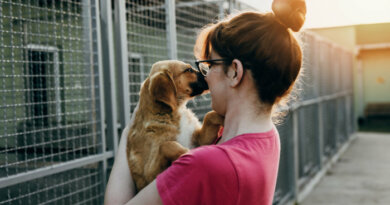How to Stop Dogs Barking and Make Them Happy
Cows moo. Cats meow. Dogs bark. Sometimes, dogs bark way too much, and that can become a problem. But it’s not as difficult a problem to solve as a lot of people think.
I don’t think anyone wants their dog to never bark. A little barking at the right time can be very useful, whether it’s to alert you to someone or something approaching your home, or to scare away threats when you’re not there. The trick is to get to that Goldilocks zone of barking — not too little, not too much, but just right.
You might be surprised to hear it, but getting to “just right” is probably a lot easier than you think.
Why do Dogs Bark?
Before you can get to the fix for any problem, you have to understand the causes. In the case of barking, it can be either wanted or unwanted, so the first question to answer is why dogs even bark in the first place.
Simply put, they bark to communicate, particularly in situations where they cannot immediately see the rest of the pack or when they want to get a message to the entire pack. In the wild, the message can be a warning of danger or a call to the hunt. When it comes from the dogs at the front of the pack, it can a way to scare off a threat.
In the wild, though, dogs don’t bark all the time. In fact, they don’t bark a lot. They save it for when they really need it. But when your dog barks constantly at home, what is it they need?
Why Do Dogs Bark Too Much?
So when a domesticated dog barks all day, what are they trying to communicate? Generally, if they do it when no one is home, it’s a sign of boredom or frustration. It can also be their way of trying to call you back, especially if the dog is experiencing separation anxiety.
The other causes, whether there are people at home or not, can be excess energy, which a dog will try to burn off through excitement and hyperactivity; or it can be due to anxiety, which leads to the dog perceiving every little noise as a possible threat to be scared away.
It may seem like something that’s impossible to control, but you have to remember why dogs bark in the first place. Communication. And what is it that one dog will try to communicate to another, or to its human pack leader? Needs. Meet the underlying need, and the excess barking will stop.
Stopping the Barking
Maybe that sounds easier said than done. But, in reality, it actually is done fairly easily. It just requires focus, commitment, and consistency on your part. It begins with correcting the unwanted barking when it happens with whatever method works for your dog, whether it’s a touch, a “tsch”, or something else. The commitment and consistency mean that you have to be ready and willing to continue the corrections until the behavior stops, and you have to always correct it when your dog barks inappropriately and you’re there.
There’s another “C” that goes with commitment and consistency, and that is “calm.” As with any correction, you have to remain calm and assertive. If you get angry or impatient, this will just amp up your dog’s energy and make barking more likely.
If the barking is always at a specific thing — like a particular door or window, or when people come in the house, then you can break the cycle by claiming that thing. That’s pretty much exactly what it sounds like. Using your body language and calm, assertive energy, create an invisible barrier between your dog and the stimulus. This sends the signal that it’s nothing they need to be concerned with or worried about, because it “belongs” to you.
Now, I know what you’re thinking. “Giving a correction is great if I’m there, but my problem is that my dog barks when I’m not home.” In that case, you need to challenge your dog, mentally and physically, in order to leave them in a state that’s directed away from unnecessary barking.
Dog Exercise
The physical challenge means exercise. Take your dog on a long walk before you leave to drain all of that excess energy and leave her in a calm, submissive state. To challenge her mentally, you can leave her with something to do, like a favorite chewy, or a “find the treat” toy that will keep her engaged until you get back.
Crate training or creating a space for your dog to go to that she’ll associate with calm and relaxation can also help. Of course, make sure that whatever you leave your dog with is safe for her to use without human supervision. Ask your vet or trainer if you have any doubts.
And don’t forget the power of asking. If you can’t solve the problem, there’s nothing wrong with consulting a behaviorist or trainer to help out.
When your dog barks, she’s trying to tell you something. By making it a two-way communication, you can give her the calmness and confidence to know that she doesn’t have to tell you everything.
Stay calm, and stop the barking!





